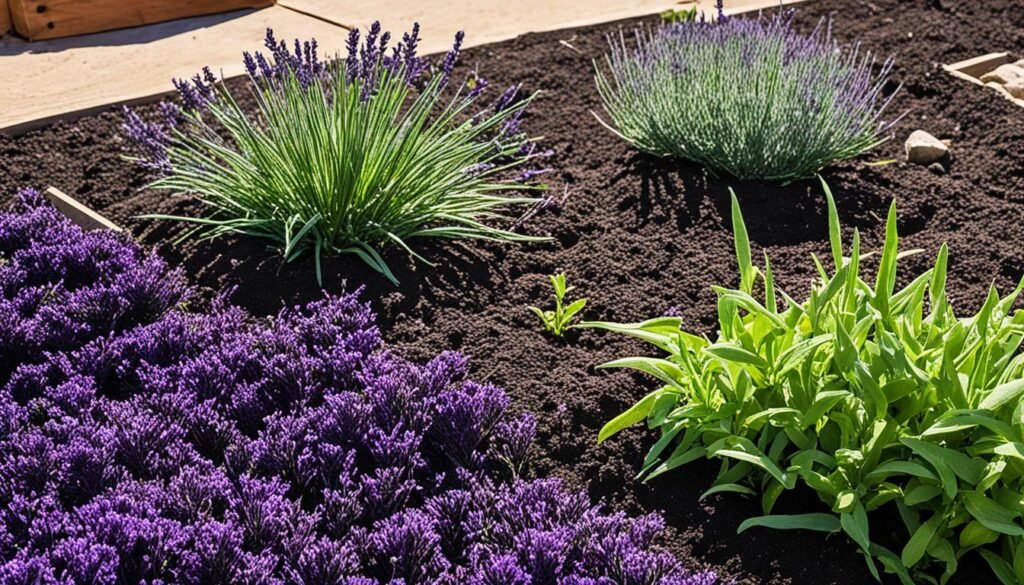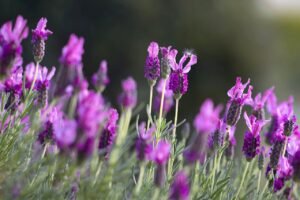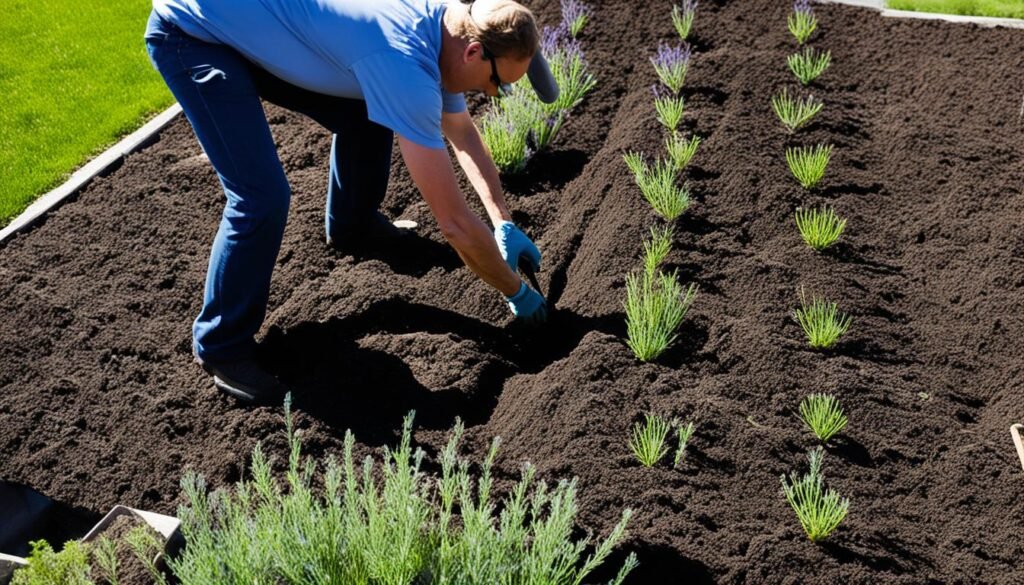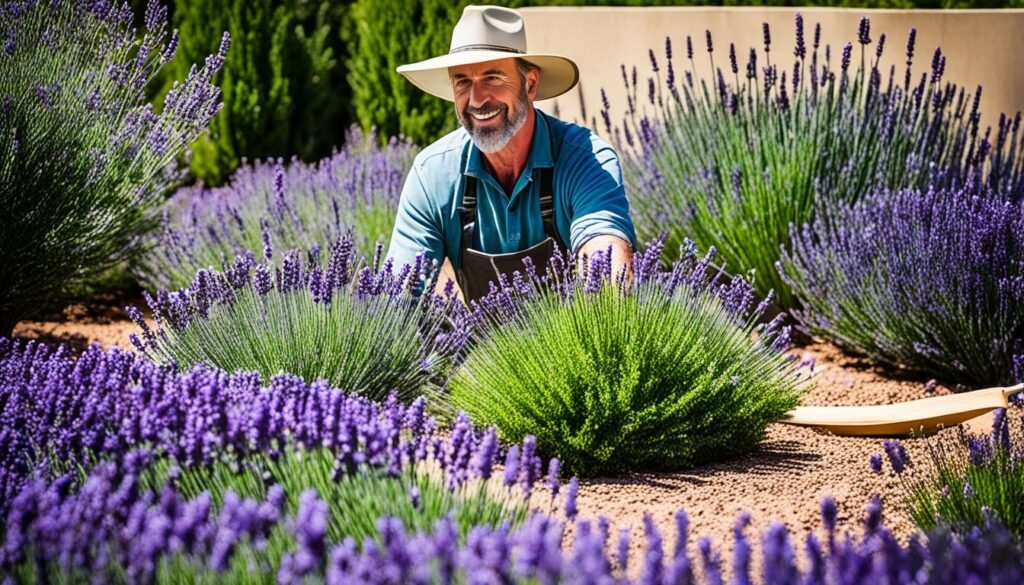Growing lavender in your garden can add a touch of beauty and tranquility to your outdoor space. Not only is lavender a visually appealing plant with its vibrant purple blooms and aromatic fragrance, but it is also relatively easy to grow and care for. Whether you are a seasoned gardener or a novice, cultivating lavender can be a rewarding experience.

In this article, I will share easy tips and practical guidance on lavender plant care and how to successfully cultivate lavender in your garden. From choosing the right lavender varieties to harvesting and using lavender, you will learn everything you need to know to create a thriving lavender garden.
Choosing the Right Lavender Varieties for Your Garden
When it comes to lavender gardening, choosing the right varieties for your garden is essential to ensure success. With numerous options available, each offering its own unique characteristics, it’s important to consider your location, climate, and personal preferences. Here are some lavender gardening tips and insights to help you select the perfect varieties for your home garden.
Lavender Varieties for Different Climates
Whether you live in a hot and dry region or a cooler climate, there is a lavender variety suitable for your garden. Let’s explore the different types:
- Lavandula angustifolia: Also known as English Lavendar, this is the most common and versatile lavender variety, known for its aromatic fragrance and beautiful purple flowers. It thrives in moderate climates and is a popular choice for gardeners.

- Lavandula stoechas: Also known as French lavender, it is characterized by its distinctive, pineapple-shaped flowers and strong fragrance. It prefers warmer climates and is a great option for areas with mild winters.

Consider Your Garden’s Aesthetic
Another factor to consider when choosing lavender varieties is the overall aesthetic you want to create in your garden. Lavender comes in various colors, ranging from deep purple and blue to pink, white, and even yellow. Select varieties that complement your existing flower beds or create a focal point in your garden.
“A garden with a variety of lavender colors creates a visual feast and adds a sense of tranquility.”
The Benefits of Lavender Varieties
Each lavender variety brings unique features and benefits to your garden:
| Lavender Variety | Key Benefits |
|---|---|
| Lavandula angustifolia | Produces high-quality lavender essential oil, ideal for aromatherapy and homemade beauty products. |
| Lavandula stoechas | Attracts pollinators like bees and butterflies, contributing to a vibrant garden ecosystem. |
Experiment and Have Fun
Remember, gardening is all about experimentation and enjoyment. Don’t be afraid to try different lavender varieties in your garden and see which ones thrive in your specific conditions. Mix and match colors and textures to create a visually stunning and fragrant oasis.
“Let your creativity blossom and transform your garden into a lavender paradise.”
By choosing the right lavender varieties for your garden, you can create a beautiful and aromatic space that brings joy and tranquility to your outdoor living area. Stay tuned for the next section, where I will guide you through preparing the soil for successful lavender planting.
Preparing the Soil for Lavender Planting
When it comes to growing lavender successfully, preparing the soil is a crucial step that cannot be overlooked. By providing the right conditions for your lavender plants, you can ensure their health and vigor, resulting in beautiful blooms and aromatic foliage. In this section, I will guide you through the best practices and lavender cultivation techniques for preparing the soil for planting.
Soil Requirements
To create an ideal environment for lavender, it is important to start with well-draining soil. Lavender plants thrive in sandy or loamy soils with good drainage, as excessive moisture can lead to root rot and other diseases. Prioritize a soil mix that promotes proper drainage to prevent waterlogging and ensure the optimal growth of your lavender plants.
pH Levels
Lavender plants prefer slightly alkaline soil with a pH level ranging from 6.5 to 7.5. It is recommended to have your soil tested to determine its pH level. If your soil tends to be acidic, you can raise the pH by adding agricultural lime. Conversely, if your soil is alkaline, you can lower the pH by incorporating organic matter like compost or peat moss.
Drainage
Adequate drainage is crucial for the overall health of your lavender plants. If your soil is heavy or compacted, it may hinder proper drainage. To improve the drainage, consider adding coarse sand or perlite to the soil mixture. This will help create air pockets and allow excess water to drain away, preventing waterlogged soil and potential root issues.
Tip: Avoid planting lavender in low-lying areas or areas prone to standing water as this can lead to root rot and other plant diseases.
Adding Organic Matter
Enriching your soil with organic matter is a great way to provide essential nutrients and improve its structure. Incorporate well-rotted compost or aged manure into the soil before planting to enhance its fertility and promote healthy root development. Organic matter also helps improve soil moisture retention and encourages beneficial soil organisms.
Remember to refrain from over-fertilizing your lavender plants, as too much nitrogen can result in excessive foliage growth at the expense of flower production. Lavender plants thrive in lean soils, so moderate fertilization with a balanced organic fertilizer during the growing season is sufficient.

| Soil Requirement | Optimal Condition |
|---|---|
| Soil Type | Sandy or loamy soil |
| pH Level | 6.5 – 7.5 (slightly alkaline) |
| Drainage | Well-draining soil |
| Organic Matter | Enriched with compost or aged manure |
By following these lavender cultivation techniques and implementing the best practices for preparing the soil, you will create an optimal growing environment for your lavender plants. This will set a solid foundation for their growth, ensuring vibrant blooms and aromatic foliage that will bring joy and beauty to your garden.
Planting Lavender: Step-by-Step Guide
Are you ready to bring the calming beauty of lavender into your garden? Follow this step-by-step guide to successfully plant lavender and enjoy its mesmerizing fragrance and stunning blooms.
Step 1: Choose the Right Spot
Find a spot in your garden that receives full sun for at least 6-8 hours every day. Lavender thrives in warm and sunny locations, so ensure the chosen spot has well-drained soil and good air circulation.
Step 2: Prepare the Soil
Before planting, prepare the soil by loosening it with a garden fork or tiller. Lavender prefers slightly alkaline soil with a pH level between 6.5-8.0. If your soil is too acidic, add lime to raise the pH level.
Step 3: Dig the Planting Hole
Using a garden trowel, dig a hole that is slightly larger than the lavender plant’s root ball. Make sure the hole is deep enough so that the crown (where the stems meet the roots) of the lavender plant sits level with or slightly above the soil surface.
Step 4: Space the Plants
When planting lavender, give each plant plenty of space to grow. Space the plants 12-24 inches apart to allow for proper air circulation and prevent overcrowding.
Step 5: Plant the Lavender
Place the plant in the hole and backfill it with soil, gently tamping it down around the roots. Water the newly planted lavender thoroughly to help settle the soil and remove any air pockets.
Step 6: Provide Adequate Water
While lavender is drought-tolerant, it is important to water newly planted lavender regularly until it establishes roots. After that, lavender plants thrive in dry conditions, so avoid overwatering to prevent root rot.
Step 7: Mulch and Weed Control
Apply a layer of organic mulch around the lavender plants to help retain soil moisture and suppress weed growth. Avoid mulching too close to the crown of the plants to prevent excess moisture accumulation.
Step 8: Prune for Growth and Shape
In the first year, pinch back the top 1-2 inches of new growth to encourage the lavender plant to develop a bushier habit. In subsequent years, prune your lavender in early spring to remove dead wood and shape the plant.
Step 9: Enjoy the Blooms!
With proper care and maintenance, your lavender plants will reward you with fragrant blooms throughout the summer months. Feel free to harvest the blooms and use them in crafts, potpourri, or as a natural air freshener.
With this step-by-step guide, you are now equipped with the knowledge to successfully plant lavender in your garden. Follow these tips, and soon you’ll be able to enjoy the delicate fragrance and beauty of lavender in your own backyard.
Lavender Plant Care: Essential Tips
When it comes to lavender plant care, there are a few essential tips to keep in mind to ensure your lavender plants thrive in your garden. By following these best practices for lavender cultivation, you’ll be rewarded with beautiful, fragrant blooms that will enhance your outdoor space.
1. Watering Schedules
Proper watering is crucial for the health of your lavender plants. While lavender is drought-tolerant, it still requires regular irrigation, especially during its first year of growth. Water your lavender plants deeply once a week, making sure the soil is evenly moist but not waterlogged. As the plants mature, reduce the frequency of watering to every two to three weeks, allowing the soil to dry out between waterings.
2. Sunlight Requirements
Lavender thrives in full sun, requiring at least six to eight hours of direct sunlight per day. Ensure that you plant your lavender in a location where it can receive ample sunlight. Lack of sunlight can result in weak, leggy plants with fewer blooms.
3. Pruning
Regular pruning is essential for maintaining the shape and health of your lavender plants. Prune your lavender in early spring or after flowering to encourage new growth and prevent woody stems. Trim the plants back by about one-third, cutting just above a leaf junction. This will help promote bushier growth and greater flower production.
4. Pest Control
Lavender plants are generally resistant to pests and diseases. However, some common pests, such as aphids and spider mites, may occasionally infest your plants. Regularly inspect your lavender for any signs of pest activity and treat as necessary. Organic insecticidal soap or neem oil can be effective options for controlling pests on lavender plants.
| Lavender Plant Care Tips | Description |
|---|---|
| Watering Schedules | Water deeply once a week, then reduce frequency to every two to three weeks as plants mature. |
| Sunlight Requirements | Plant lavender in a sunny location with at least six to eight hours of direct sunlight. |
| Pruning | Trim lavender plants by about one-third in early spring or after flowering to promote bushier growth. |
| Pest Control | Regularly inspect lavender plants for pests and treat with organic insecticidal soap or neem oil if necessary. |
By following these essential lavender plant care tips, you’ll be well on your way to cultivating healthy and thriving lavender plants in your garden. Remember to provide adequate water and sunlight, prune regularly, and keep an eye out for pests. With a little care and attention, your lavender plants will reward you with their stunning beauty and delightful fragrance.
Harvesting and Using Lavender
When it comes to lavender gardening, knowing the right time to harvest your blooms is essential. The ideal time for harvesting lavender is when the flowers have just begun to open and the color is vibrant. This is typically during the summer months when the plant is in full bloom.
To harvest lavender, simply cut the stems just above the leaves using sharp pruning shears. Be sure to leave some foliage on the plant to allow for continued growth. Once harvested, you can then move on to drying and storing your lavender for later use.
Drying and Storing Lavender
Drying lavender is a straightforward process that allows you to preserve its fragrance and use it in various ways. After harvesting, bundle the stems together and hang them upside down in a cool and dark area, preferably a well-ventilated room or closet. Allow the bundles to dry completely, which typically takes about two weeks.
Once dried, remove the lavender buds from the stems by gently rubbing them between your fingers. Store the dried buds in an airtight container, such as a glass jar, away from direct sunlight and moisture. This will ensure the longevity of the lavender’s fragrance and flavor.
Using Lavender in Your Everyday Life
Lavender is a versatile herb that can be used in a variety of homemade products and for aromatherapy purposes. Here are a few creative ways to incorporate lavender into your daily routine:
- Create a calming lavender-infused oil by steeping dried lavender buds in a carrier oil, such as almond or jojoba oil. This can be used as a massage oil or added to bathwater for a relaxing soak.
- Add dried lavender buds to homemade potpourri or sachets to infuse a room with a delightful fragrance.
- Make lavender-scented candles by melting candle wax and adding a few drops of lavender essential oil. Pour the melted wax into candle molds and let it solidify.
- Enhance your culinary creations by incorporating dried lavender buds into baked goods, teas, or infused honey.
- Check out our other blogs on how else you can use lavender



By harvesting and utilizing your own lavender, you can enjoy the numerous benefits and aromatic wonders that this beautiful herb has to offer.
What to Do After the Harvest
Now that you’ve successfully harvested your lavender blooms, it’s time to focus on the next steps to ensure the continued health and vitality of your plants. Proper post-harvest care is crucial in maintaining a thriving lavender garden. Follow these lavender gardening tips and lavender cultivation techniques to keep your plants in top shape.
1. Pruning
After harvesting, it’s essential to prune your lavender plants to promote new growth and maintain their shape. Trim back any spent flower stems and remove any dead or damaged foliage. Be careful not to prune too much, as lavender plants need green foliage to stay healthy.
2. Maintenance
Regular maintenance is key in preventing diseases and pests from affecting your lavender plants. Keep an eye out for any signs of mold, mildew, or insect infestations. If you notice any issues, address them promptly by removing affected parts or treating them with organic remedies.
3. Preparing for the Upcoming Season
As the current season comes to an end, it’s essential to prepare your lavender plants for the upcoming season. Clear any debris from around the plants to improve air circulation and prevent moisture buildup. Apply a layer of organic mulch around the base of the plants to help conserve moisture and protect against temperature fluctuations.
By following these lavender gardening tips and lavender cultivation techniques, you can ensure that your lavender plants thrive year after year. Now that you know what to do after the harvest, it’s time to get out into your garden and put these tips into practice.
4. Propagating Lavendar
Propagating lavender is relatively easy and can be done through various methods such as stem cuttings or layering. To propagate from stem cuttings, select healthy, non-flowering stems and trim them just below a leaf node. Remove the lower leaves and place the cuttings in a well-draining potting mix. Keep the soil moist but not waterlogged and provide indirect light until roots develop, usually in a few weeks. Once rooted, transplant the cuttings into individual pots or directly into the garden for beautiful new lavender plants.

| Lavender Gardening Tips | Lavender Cultivation Techniques |
|---|---|
| Prune your lavender plants after harvesting to promote new growth and maintain their shape. | Ensure regular maintenance to prevent diseases and pests from affecting your lavender plants. |
| Clear debris from around the plants and apply organic mulch to prepare for the upcoming season. | Be attentive to signs of mold, mildew, or insect infestations and address them promptly. |
Conclusion
After exploring the wonderful world of growing lavender in your garden, it’s clear that this versatile plant is a must-have for any green thumb. With the tips and techniques shared in this lavender growing guide, you now have the knowledge and confidence to cultivate a thriving lavender garden of your own.
Remember, selecting the right lavender varieties for your garden is crucial. Consider factors such as your location, climate, and personal preferences to ensure a successful growing experience. Preparing the soil with the right pH levels, drainage, and organic matter will set the stage for healthy lavender plants.
When it comes to planting lavender, follow the step-by-step guide provided in this article to ensure proper spacing, depth, and watering. As your lavender plants grow, pay attention to essential care tips such as watering schedules, sunlight requirements, and pest control. Taking the time to prune and harvest your lavender blooms at the optimal time will result in beautiful, fragrant yields.
As you embrace the joys of growing lavender, don’t forget to explore the diverse uses for this aromatic herb. Whether you’re drying and storing lavender for homemade products or enjoying the soothing effects of lavender in aromatherapy, the possibilities are endless.
Don’t forget! Lavendar is a perennial plant. This means it will regrow each year. Lavender is resilient and can endure through the winter months with proper care. This aromatic herb is hardy in colder climates, often maintaining its foliage and structure even as temperatures drop. With adequate protection from harsh conditions and occasional pruning to maintain shape, lavender can continue to thrive through the winter, adding beauty and fragrance to the garden even in the coldest months.
So, let’s get started on your lavender journey! Embrace the calming beauty and enchanting fragrance that lavender brings to any garden. With the knowledge you’ve gained from this lavender growing guide, your garden will soon become a lavender haven.
Disclosure: This article contains affiliate links from Amazon. If you purchase from the link, we will make a small commission with no additional cost to you.





Ohhh this looks awesome. I’m a total beginner when it comes to gardening but I’m adding this to the list. You really had me at attracting butterflies, that’s what I really want! Saving this post. Thanks!
You’re Welcome!!! Happy Gardening!
I have some seeds and a limited gardening area. Is it possible to grow lavender in a pot?
Yes! Lavender will do wonderful in a pot as long as it has good drainage and lots of sunlight. We use grow bags at our house. I grow a lot in those. Looking forward to your luscious lavender pot! Good luck!